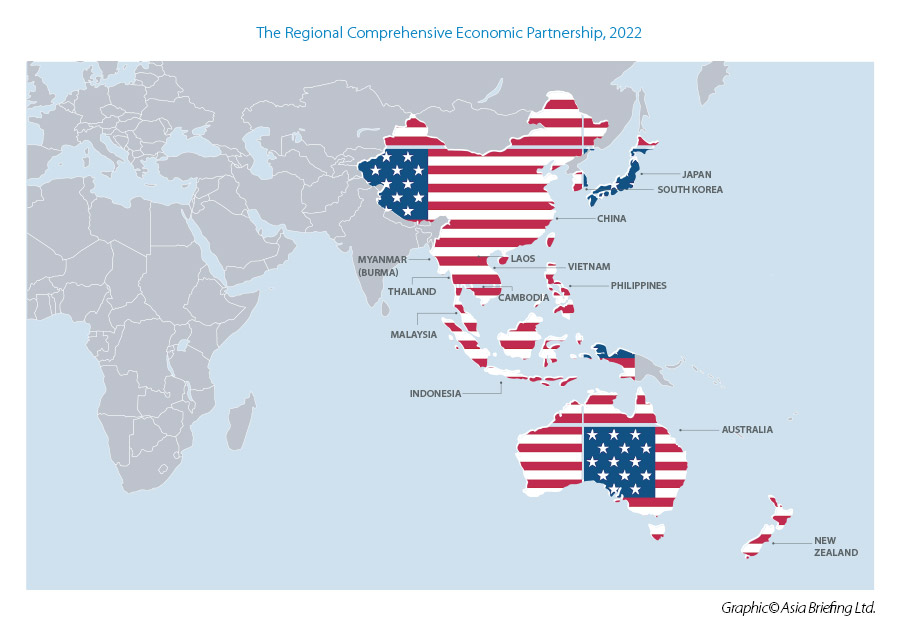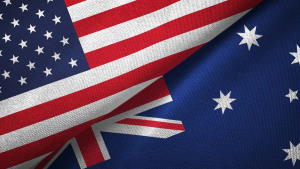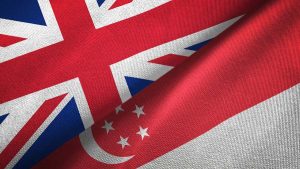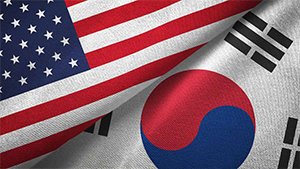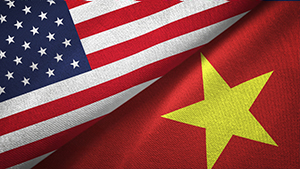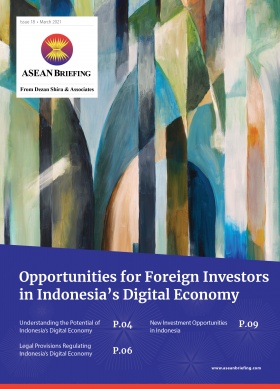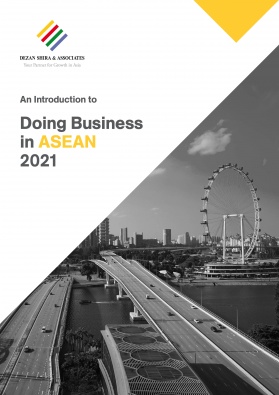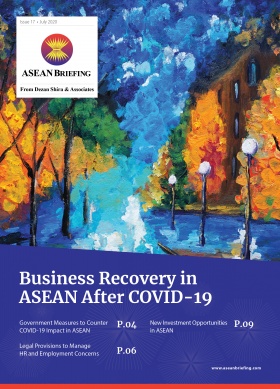How US Businesses Can Access the East Asian US$25 Trillion RCEP Free Trade Market Agreement via Existing Agreements
China has ratified the much-anticipated Regional Comprehensive Economic Partnership (RCEP) free trade agreement and said that it hopes other members will ratify the deal for it to take effect from January 1, 2022. That is just five months from now.
The RCEP free trade agreement (FTA) includes China, Japan, South Korea, the ASEAN nations of Brunei, Cambodia, Indonesia, Laos, Malaysia, Myanmar, Philippines, Singapore, Thailand, and Vietnam together with Australia and New Zealand.
For US businesses and investors, the RCEP’s sheer size makes it significant. Participating economies account for 29 percent of global GDP and about 30 percent of the world’s population. This equates to a market value of close to US$25 trillion and a total consumer base of about 2.5 billion, of whom an estimated 1 billion are middle-class consumers.
The primary aim of the RCEP is to establish a comprehensive economic partnership – building on existing bilateral ASEAN agreements within the region with its FTA partners. It will be guided by a common set of rules and standards, including lowered trade barriers, streamlined processes, and improved market access. For investors, RCEP delivers substantial new trade and investment opportunities within the participating countries and forms Asia’s largest trade bloc to date.
The RCEP agreement includes 20 chapters covering many of the articles typically found in a free trade agreement. Notably, it makes significant strides by harmonizing the rules of origin and strengthening IP measures. We can examine some of the primary issues as follows:
Common rules of origin
One of the most significant aspects under RCEP is that the rules of origin will be unified for the entire bloc. This will mean that investors will only require one certificate of origin for trading in the region and can bypass the tedious processes of checking and adjusting to the specific rule of origin criteria in each country. When implemented, investors can expect lower costs, added flexibility, and regional supply chains streamlined.
Trade in goods – Reduced tariffs
Under RCEP, tariffs will be eliminated on around 92 percent of goods implemented progressively over the next 20 years, in accordance with each party’s Schedule of Tariff Commitments. This will allow participating countries to gain preferential market access with each other. However, some agricultural and sensitive goods will be excluded from these tariff reductions.
Trade in goods – Simplified customs procedures
Simplified customs procedures and enhanced trade facilitation provisions will allow efficient administration of procedures and expeditious clearance of goods, including the release of express consignments and perishable goods within six hours of arrival.
Trade in services
Under RCEP, at least 65 percent of the services sectors will be fully open to foreign investors, with commitments to raise the ceiling for foreign shareholding limits in various industries, such as professional services, telecommunications, financial services, computer services, and distribution and logistics services.
Not unlike the negative list system in China, RCEP will also take on a ‘negative-list’ approach where the market will be fully open to foreign service suppliers unless it appears on the list. This ensures transparency of regulations and measures which will allow greater certainty for businesses.
Investment
RCEP eases the process required of investors entering, expanding, or operating in RCEP countries. It also prevents the adoption of further restrictive measures and includes a built-in investor-state dispute settlement mechanism that can be revoked by the member states.
Intellectual protection
RCEP raises the standards of IP protection and enforcement in all participating countries. Aside from securing the protection rights for copyright, and trademark in the normal sense, it also goes further to protect non-traditional trademarks (sound marks, wider range of industrial designs) and forms of digital copyright, which goes beyond what was included in the CPTPP.
E-commerce
The agreement covers areas, such as online consumer protection, online personal information protection, transparency, paperless trading, and acceptance of electronic signatures. It also includes commitments on cross-border data flows. This provides a more conducive digital trade environment for businesses and provides for greater access to RCEP markets.
Government procurement
Participating RCEP countries have committed to publishing laws, regulations, and procedures regarding government procurement, as well as tender opportunities if available. This allows greater transparency for businesses to pursue government procurement market opportunities in the region. RCEP has also committed to a review aimed at improving this in the future.
Although the United States is not a signatory to the RCEP agreement, there are indirect ways in which American businesses can access this market, including China, through the back door. This is because the United States has signed Free Trade Agreements with three of the member states of RCEP: Australia, Singapore South Korea, and has a Bilateral Trade Agreement Vietnam.
We can examine these as follows:
The US-Australia Free Trade Agreement
The United States has had a free trade agreement with Australia since 2004. As a result of the FTA, tariffs that averaged 4.3 percent were eliminated on more than 99 percent of the tariff lines for qualifying US manufactured goods exported to Australia. In addition to tariff elimination, the FTA affords substantial benefits in a broad range of other sectors.
The FTA opened markets for services such as life insurance and express delivery, improved protection of intellectual property, and helped facilitate American investments through predictable access and a stable business environment. For the first time, in many sectors, American firms are now allowed to compete for Australia’s government purchases on a nondiscriminatory basis. US farm exports benefit from duty-free treatment, including processed foods, fruits and vegetables, corn, and soybeans. The FTA also made advances in e-commerce and market access for pharmaceuticals.
Although Australia is a mature market, there may be opportunities to use the US-Australia FTA to access RCEP and the emerging markets within RCEP – specifically Cambodia and Laos – to perform certain finishing functions under the RCEP agreement. That would reduce production costs and help develop these smaller countries’ production facilities.
Dezan Shira & Associates has several partner firms in Australia. For assistance with US investments into the country, and advice about using an Australian presence to access RCEP please email us at asia@dezshira.com.
The US-Singapore Free Trade Agreement
The United States and Singapore signed an FTA in May 2003. The agreement binds all Singapore tariffs for U.S. goods at zero, while the FTA has increased export opportunities for certain U.S. manufacturing sectors, including those that produce medical instruments and equipment, microelectronics, photo equipment, certain textiles, pharmaceuticals, and chemicals. Singapore also has accorded substantial access to its services and investment market, with few exceptions. It also has increased government procurement opportunities and the protection of intellectual property. Furthermore, the FTA provided groundbreaking cooperation in promoting labor rights and the environment.
The financial services sector benefits particularly in greater collaboration on cross-border know-your-customer (KYC) processes, skills development, cybersecurity, and green finance.
US companies can examine where the USSFTA overlaps with RCEP and use Singapore as a hub to reach out to the full RCEP markets. Singapore is especially useful as a regional hub as it possesses intra-RCEP banking facilities and other financial and logistics services that are not so easily accessible from the US. Singapore is developing as a massive global e-commerce hub for these reasons. Establishing a US E-commerce business in Singapore would provide access to the RCEP agreement that Singapore has signed. Companies established in Singapore maybe 100 percent foreign (i.e: American) owned.
Singapore enjoys a corporate income tax rate of 17 percent, with no taxes due on profits realized externally from Singapore. Singapore follows a progressive resident tax rate starting at 0 percent and ending at 22 percent above US$320,000 (£170,000). There is no capital gain or inheritance tax. Income earned by individuals while working overseas is not subject to taxation barring a few exceptions.
Dezan Shira & Associates has an office in Singapore and many of the RCEP member countries and can assist with planning a market entry access strategy. Please contact us at singapore@dezshira.com. Our Doing Business in Singapore guide can be downloaded for free here.
The US-South Korea Free Trade Agreement
The United States has had an FTA with South Korea (known as Korus) since 2012. Upon implementation, almost 80 percent of US industrial goods exports to South Korea became duty-free, including aerospace equipment, agricultural equipment, auto parts, building products, chemicals, consumer goods, electrical equipment, environmental goods, travel goods, paper products, scientific equipment, and shipping and transportation equipment. Other benefits of the FTA include stronger protection and enforcement of intellectual property rights in South Korea and increased access to South Korea’s US$580 billion services market for American companies.
South Korea is a mature market, however, there may be opportunities to use the Korus FTA to access RCEP and the emerging markets within RCEP – specifically Cambodia and Laos – to perform certain finishing functions under the RCEP agreement. That would reduce overall production costs and assist with globally competitive pricing and margins.
Dezan Shira & Associates has a Partner firm in Seoul. For inquiries about US investments into South Korea and how to access the RCEP agreement through investments into the country, please email us at asia@dezshira.com.
Specific advantages and protocols of the US free trade agreements
Each of these FTA has similar rules, as follows. For exact information pertinent to each country, examine the specific FTA, however, these are the general applications:
Rules of origin
For goods that are not wholly obtained, US exporters must meet the product’s rule of origin, usually through Tariff Shift or Regional Value Content. The rules of origin may be found in the final text of the FTA. Occasionally, a particular rule of origin may be revised. For the most updated version of the ROOs consult the Harmonized Tariff Schedule of the United States, General Notes — General Note 25.
In addition to the above rules of origin, there may be other ways to qualify your product:
- Accumulation may allow the producer to reduce the value of the non-originating materials used in the production of the good;
- De Minimis allows the exporter to disregard a very small percentage of non-originating materials that do not meet a tariff shift rule;
- Direct Shipment are goods that must be shipped directly from one FTA party to another FTA party;
- Fungible Goods and Materials refers to goods or materials (components) that are interchangeable for commercial purposes and whose properties are essentially identical; and
- Indirect Materials are goods used in the production, testing, or inspection of a product but not physically incorporated into the goods.
Claiming/Documenting origin
No specific certification is required for the US FTA. Exporters may be required by the importer to provide information to support a claim of preferential treatment.
The US-Vietnam Bilateral Trade Agreement
The U.S.-Vietnam Bilateral Trade Agreement (BTA) differs from a complete FTA, however, is a comprehensive document covering trade in goods, protection of intellectual property rights, trade in services, investment protection, business facilitation, and transparency. The 140-page agreement, which took almost five years to negotiate and put into effect, is highly technical and was written to accord with World Trade Organization (WTO) and other international trade and investment principles. The BTA can basically be summarized as a commitment by both sides to create necessary conditions for the products, businesses, and nationals of the other side to have fair access to compete in the other’s markets.
When the BTA went into effect on December 10, 2001, the U.S. immediately provided Vietnam’s goods and companies access to the US market — a market that represents nearly a third of world GDP — on the same basis it grants to other countries with which it has normal trade relations.
Among other things, this means Vietnam’s products are now assessed much lower tariffs — dropping from an average of 40 percent to an average of three percent — when they enter the U.S. For Vietnam’s part, Vietnam has committed to reform its trade and investment regime to provide a much more level and fairer “playing field” for US companies and products in Vietnam. In many cases, Vietnam’s commitments are phased in over several years in recognition of the transitional state of Vietnam’s economy and the significant reforms necessary to bring its regulatory regime into compliance with international norms. The BTA is the most comprehensive trade agreement Vietnam has signed to date.
Vietnam is an emerging economy and offers different potential for US businesses looking to access the RCEP markets. Vietnam is a suitable manufacturing and trading base from which to reach out to RCEP given its increasing productivity, worker skill set yet competitive labor market. US businesses investing in Vietnam may find the country an excellent competitive base from which to reach out to RCEP.
Vietnam enjoys a Corporate Income Tax rate of 20 percent, and taxes personal income at rates starting at 0 percent and ending at 35 percent.
Dezan Shira & Associates have three offices in Vietnam and can assist with planning an entry access strategy to give access to RCEP. Please contact us at vietnam@dezshira.com. Our Doing Business in Vietnam guide can be downloaded for free here.
Other US-RCEP beneficial trade and tax agreements
American businesses overseas can access regional trade agreements by virtue of being locally domiciled. Most of the RCEP nations permit 100 percent foreign ownership although certain industry sectors may require a local partner. General manufacturing and trading services however can usually be held 100 percent. Establishing a business in Asia is usually not that expensive, although some thought needs to be put into place as concerns where. Typically, different countries offer certain trade and commodity benefits that others may not have and be stronger in certain industry sectors. Operational costs and productivity rates also vary.
Pending US trade agreements with RCEP members
Apart from the agreements listed above, the US has pending agreements with RCEP members New Zealand and Indonesia. Discussions with Malaysia and Thailand have been in abeyance since 2008.
US-RCEP double tax treaties
Double Tax Treaties (DTA) do not deal directly with free trade but are useful in determining bilateral preferential tax treatments between countries. This is especially pertinent in the services industries. Professionally utilized DTA can reduce profits tax burdens on bilateral contracts by typically 10 percent when conducting trade overseas. The United States has DTA in place with RCEP members Australia, China, Indonesia, Japan, New Zealand, Philippines, South Korea, and Thailand. Please contact us at asia@dezshira.com for advisory services related to US tax treaties with any of these countries.
Understanding the strategic use of the United States’ existing free trade, bilateral, and double tax agreements with RCEP members requires professional advice. The US FTA with Japan, Singapore, South Korea, and the US-Vietnam Bilateral Trade Agreement should be studied, in conjunction with the applicable DTA, and analyzed to note where RCEP compatibility occurs. Dezan Shira & Associates has conducted extensive research into this issue and has professionals on the ground in our offices throughout the Asian region and liaison offices in the United States. For assistance with developing a US-RCEP market access strategy, please contact us at asia@dezshira.com or visit us at www.dezshira.com.
About Us
ASEAN Briefing is produced by Dezan Shira & Associates. The firm assists foreign investors throughout Asia and maintains offices throughout ASEAN, including in Singapore, Hanoi, Ho Chi Minh City, and Da Nang in Vietnam, Munich, and Esen in Germany, Boston, and Salt Lake City in the United States, Milan, Conegliano, and Udine in Italy, in addition to Jakarta, and Batam in Indonesia. We also have partner firms in Malaysia, Bangladesh, the Philippines, and Thailand as well as our practices in China and India. Please contact us at asia@dezshira.com or visit our website at www.dezshira.com.

